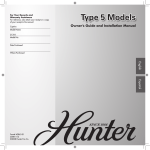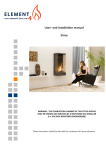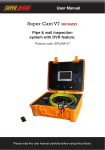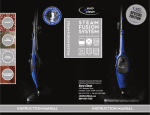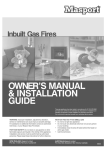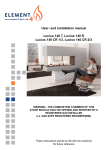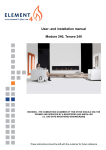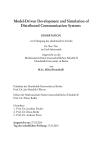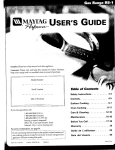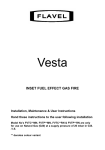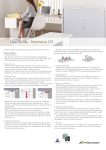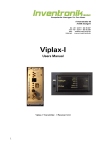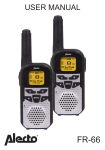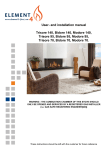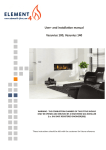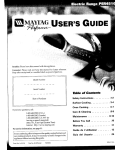Download User- and installation manual Sirius
Transcript
User- and installation manual Sirius WARNING - THE COMBUSTION CHAMBER OF THIS STOVE SHOULD ONLY BE OPENED AND SERVICED BY A REGISTERED GAS INSTALLER (i.e. GAS SAFE REGISTERED ENGINEER[GB]) These instructions should be left with the customer for future reference This Manual Covers the following appliances: Sirius Contents GENERAL INFORMATION............................................................................................................3 Important Safety Notice..................................................................................................................3 General Fitting Information....................................................................................................4 USER INFORMATION...................................................................................................................5 Remote Control Electronic Ignition System RCE GV60................................................................5 INSTALLER INFORMATION.......................................................................................................10 Ventilation............................................................................................................................10 General Balanced Flue Notes / Appliance Fireplace installation.........................................10 Terminal Locations Wall Mounting.......................................................................................12 Terminal Locations Roof Termination...................................................................................13 Concentric Flue Parts Identification.....................................................................................14 Rigid Balanced Flue Connection Possibilities......................................................................21 Vertical Roof Terminations...................................................................................................22 Installing Remote Control Electronic Ignition System GV60........................................................23 Arranging The Ceramic Fire-bed..................................................................................................24 Log Arrangements...............................................................................................................24 Gravel Arrangements...................................................................................................................25 COMMISSIONING THE APPLIANCE..........................................................................................25 Installation tips.............................................................................................................................26 Installing gasfire Sirius .............................................................................................................26 Servicing Instructions...................................................................................................................28 Troubleshooting............................................................................................................................29 TECHNICAL INFORMATION.......................................................................................................31 Dimensions...................................................................................................................................31 Technical Details..........................................................................................................................32 Warranty.......................................................................................................................................35 2 GENERAL INFORMATION Important Safety Notice a registered gas installer be employed for this task. The engineer will provide you with information about the safety limits of the installation and should fix a notice plate in a place where it can be readily seen. This appliance has a ceramic Fire-bed arrangement; this contains Refractory Ceramic Fibres, which are man-made vitreous silicate fibres. Excessive exposure to these materials can cause irritation to eyes, skin and respiratory organs. Hence we recommend that when handling these materials the release of dust should be kept to a minimum. During installation and servicing we recommend that a HEPA filtered vacuum be used to remove any dust and soot in and around the fire. If any of the ceramic fire-bed components need to be replaced we recommend that the removed parts be sealed in a heavy-duty polythene bag, and be labelled as RCF waste. RCF is not “Hazardous waste” and can be disposed of at a licensed tipping site for the disposal of industrial waste. This appliance is designed as an efficient heating device and consequently all body parts become very hot in use. Except for the control knob and control access door, which are designed to stay cool, all other parts are working surfaces and should not be touched. The glass and frame on this appliance acts as a fireguard conforming to BS: 1945 – 1971 and satisfies the Heating Appliance (Fireguards) regulations 1991. No part of the window or frame should be permanently removed. It does not give protection for young children aged or infirm, extra guarding(conforming to BS8423: 2002) should be considered so the special hazards that exist in nurseries and other places where there are young children, aged or infirm persons are minimized. The appliance incorporates a permanent pilot. This is located on the front of the burner, and must not be adjusted by the installer. This system must not be put out of operation, and if any parts require changing, only original manufacturer parts shall be used. Bearing in mind that the heat given off by this appliance may affect articles placed close to it, curtains should not be placed within 30cm. This appliance is designed to be used either Natural or LPG gas however, each individual appliance is only capable of running off the type of gas specified at the time of purchase. It is important to note that once a type of gas has been specified the stove cannot run off any other type. The type of gas that your stove is capable of burning is stated on the data information panel. The appliance is not designed as a dryer. It is not therefore recommended that the appliance be used in such a manner. Do not place any articles within 30cm of this appliance as this may result in damage to the articles. The installation must be carried out in accordance with the following regulations: This appliance has been designed, tested and approved to meet standards in place for product use, performance and safety. Installation of your appliance must comply with current building regulations. It is therefore recommend that The Building Regulations issued by the Depart 3 GENERAL INFORMATION ment of the Environment, the Building Standards (Scotland) (Consolidation) Regulations issued by the Scottish Development Department. If the appliance is to be fitted against a wall with combustible cladding, the cladding must be removed from the area covered, above and around. BS 5440 part 1, BS 5871 part 2 and BS 6891. As on all heat producing appliances, soft furnishes such as blown vinyl wallpaper placed too near to the appliance may become scorched or discoloured. This should be born in mind when installing the appliance. In the Republic of Ireland the installation must also conform to the relevant standards, particularly in regard to flue sizing and ventilation. Refer to documents IS813, ICP3, IS327 and any other rules in force. Note: Since the appliance is a source of heat, circulation of air occurs. Therefore it is of importance that you do not use the appliance shortly after a renovation of the home. Because of the natural circulation of air, moist and volatile components from paint, building materials, carpet etc. will be attracted. These components can settle themselves down onto cold surfaces in the form of soot. This appliance must be installed in accordance with the rules in force and used only in a sufficiently ventilated space, and is intended for use on a gas installation with a governed meter. Before installation, ensure that the local distribution conditions (identification of the type of gas and pressure) and the adjustment of the appliance are compatible. The technical specification of this appliance is given on the rear page of this manual. Prevention of Rust: Always switch off the fire completely after use. Do not leave pilot flame on.This saves gas and prevents corroding of your fire. Do not use the appliance if the glass front door or panel has been broken, removed or is open. General Fitting Information Inlet pipe connection 8mm compression Chimney requirements Balanced Flue Flue monitor Permanent Pilot Positioning the appliance This appliance has been designed to hang against a wall. This wall must be made of noncombustible and heat resistant material. User control: Variable rotary control inc. integrated Piezo ignition, Permanent pilot facility, Flame failure device and Oxygen Depletion Cut-out. The plaster of the wall has to be resistant to a high temperature. Use therefore the plaster materials especially made for this to prevent discoloring (min. 100 degrees temperature resistant). Before installation of these appliances, the area into which the fire is to be fitted must be cleared of all debris (including dust), in particular combustible material. 4 Remote control electronic ignition system RCE GV60 - temperature display in degrees Celsius or Fahrenheit; - time; thermostat function; The appliance supplied with a remotesyscontrol. --temperature display in degrees Celsius or Remote control iselectronic ignition temperature display in degrees Celsius or Remote control electronic ignition timer for thermostat function. controlling the flame height and switch- Fahrenheit; temIgnition, RCE GV60 Fahrenheit; system RCE GV60 ing off are performed by the remote control that - time; - time;Setting the communication code operates ais receiver thea control The appliance supplied in with remote hatch. control.For - thermostat function; - thermostattofunction; The appliance is suppliednowith a remote control. putting the application some appliances, control hatch supplied. -Prior timer for thermostat function. into operation, a Ignition, controlling the flame height andisswitchtimer for thermostat function. Ignition, controlling height and switchcommunication code must be set between the In are that case, the the flame receiver is placed under ing off performed by the remote control that the ing offappliance. are performed by the remote controlcontrol that remote control and the receiver. The code is choTheinreceiver andhatch. remote operates a receiver the control For someare Setting the communication code Setting communication code available codes. operates a receiver in the receiver control hatch. For senthe randomly the 65000 battery powered. requires Prior to puttingfrom the application into operation, a appliances, no controlThe hatch is supplied. In 4that Prior to putting the application into operation, a somepenlite appliances, no control hatchthe is remote supplied. As a result, the chance that other remote controls (AA type) batteries, control communication code must be set between the case, the receiver is placed under the appliance. communication code must be set code between the the In thatrequires case, the receiver is placed under the near you are using the same and affect 3 xremote AAA penlites The receiver and control .At are normal battery use, pow- the remote control and the receiver. The code is choremote control and the receiver. The code choappliance. The receiver and remote control are operation of your very is small. will have an average life of one year. sen randomly fromappliance the 65000isavailable codes. As ered.batteries The receiver requires 4 sen randomly from the 65000 available codes. battery powered. The receiver requires 4 You(AA cantype) also use an optional adapter.control Ask your a result, the chance that other remote controls penlite batteries, the remote As a result, chance that other remotebelow: controls penliteinstaller (AA type) batteries, the remote control Followthe the procedure described information. that case requires 3 x for AAA penlites .AtInnormal use,you thewill near you are using the same code and affect the aredown usingthe the same button code and the requires AAAVpenlites .At normal use, the near you Hold onaffect the receiver, need3will ax 230 appliance. operation of yourreset appliance is very small. batteries have connection an averagenear life your of one year. your appliance is very small. batteries will have an average life of one year. operation untilof you hear two consecutive sound signals You can also use an optional adapter. Ask your You can also use an optional adapter. Ask your (see fig. After thedescribed second, below: longer signal, Follow the2). procedure installer for information. In that case you will need procedure described below: installer for information. In that case you will Followletthe godown of thethe reset button. Hold reset button on the receiver, a 230 V connection near your appliance. down the reset button on the receiver, need a 230 V connection near your appliance. Hold Press button until you hear two consecutive sound signals until you hear two consecutive sound signals (see fig. 2). After the second, longer signal, let (see fig. 2). After the control second,within longer20 signal, onof the seconds, go theremote reset button. let gountil of the reset button. hear a sound signal: this is the Press you button Pressconfirmation button of a correct communication. USERINFORMATION INFORMATION USER !Caution When installing a new remote conon the remote control within 20 seconds, until on the remote control within 20 seconds, trol or receiver, you must set a new commuyou hear a sound signal: this is the confirmauntil nication you hearcode. a sound signal: this is the tion of a correct communication. confirmation of a correct communication. !Caution When installing a new remote control !Caution When installing a new remote conor receiver, you must set a new communicatrol or receiver, you must set a new commuThe appliance’s standard functions such as igni- tion code. nication code. tion, controlling the flame height, standby (pilot burner) position and switching off ,are performed in the MAN position. the display of the remote The appliance’s standardInfunctions such as igniThe appliance’s standard functions as ignican see theflame letters MAN.such tion, you controlling the height, standby (pilot tion, controlling the height, standby (pilot In addition, theflame remote control canperformed also be used burner) position and switching off ,are burner) position and switching off ,are performed set aposition. number of the additional in thetoMAN In displayfunctions: of the remote in the MAN position. In the display of the remote you can see the letters MAN. you can see the letters MAN. In addition, the remote control can also be used In addition, the remote control can also be used to set a number of additional functions: to set a number of additional functions: 1 1 2 2 5 5 5 USER INFORMATION USER INFORMATION USER INFORMATION MAN MANposition position MAN position ByBybriefly brieflypressing pressingthe theSET SETbutton, button,you you will will go go By briefly pressing the SET button, you will go through the following functions: through the following functions: through the following functions: MAN → →TEMP → (P*)TIMER → MAN→→ TEMP TEMP TEMP → (P*)TIMER MAN → TEMP → TEMP → (P*)TIMER MAN → MAN → MAN where, where,depending dependingononthe thetimer timersetting: setting: where, depending on the timer setting: (P*) is displayed as P1 , , P1 ,, (P*) is displayed as P1 , , P1 , P2 , P2 (P*) is displayed as P1 , , P1 , P2 , P2P2 . . P2 . ✹ ow llo I gIngi nt ei t et h teh ea pappl ipalni ac n e c ea s a sf o l fl o s :w s : Ignite the appliance as follows: S e button t button n t hgas e g acontrol s contro Set A A ono the tol t o Set button A on the gas control to (button B is controlled automatically). ONON (button B is controlled automatically). ON (button B is controlled automatically). The gas control locatedininthe thecontrol controlhatch hatch or The gas control is islocated The gas control is located in the control hatch or is is placed placed under under the the appliance. appliance. or is placed under the appliance. ✹ You position by Youcan canalso alsogo goback backto to the the MAN MAN position by You can also go back to the MAN position by pressing the button (large flame) or Simultaneously press buttons pressing the button (large flame) or Simultaneously press thethe buttons pressing the button (large flame) or Simultaneously press the buttons (small flame). and remote control. (small flame). and onon thethe remote control. (small flame). and on the remote control. !Caution - When pressing the buttons (with the !Caution - When pressing the buttons !Caution - When pressing the buttons exception the SET button), the transmission (with theofexception of the SET button), the (with the exception of the SET button), the symbol ( )symbol will appear indicate that transmission ( )towill appear to transmission symbol ( ) will appear to transmission is taking place between the remote indicate that transmission is taking place indicate that transmission is taking place control andthe theremote receiver; between control and the receiver; between the remote control and the receiver; - -The receiver acknowledges transmission The receiver acknowledges the the transmission - The receiver acknowledges the transmission with a sound signal; with a sound signal; with a sound signal; - -The appliance The appliancewill will automatically automatically enter enter the the - The appliance will automatically enter the standby position, if there is no transmission for standby position, if there is no transmission standby position, if there is no transmission 6 for hours. 6 hours. for 6 hours. Set the remote control to the MANMAN position. Set the remote control to the position. Set the remote control to the MAN position. Ignition Ignition Ignition Caution - During the ignition process, you areyou not Caution - During the ignition process, Caution - During the ignition process, you allowed operate to control button B are nottoallowed operate control button B are not allowed to operate control button B onon the gas control manually the gas control manually on the gas control manually - Always wait 5 minutes - Always wait 5 minutesafter afterthe thepilot pilot burner burner - Always wait 5 minutes after the pilot burner has hasgone goneout, out,before beforeyou youre-ignite re-ignite has gone out, before you re-ignite the appliance; the appliance; the appliance; 33 BB AA buttons when a short sound LetLet gogo of of thethe buttons when a short sound Let go of the buttons when a short sound signal indicates that ignition process signal indicates that thethe ignition process hashas signal indicates that the ignition process has been started. been started. been started. succession: In In succession: In succession: - thecontinuous continuoussignals signals will will indicate - the indicate that thatthe theigni- the continuous signals will indicate that the tion process ignition processisisactive; active; ignition process is active; a short sound signalwill willindicate indicatethat thatthe theigniignition - a- short sound signal - a short sound signal will indicate that the igniprocess has finished; tion process has finished; tion process has finished; - the appliance automatically switch through - the appliance willwill automatically switch through - the appliance will automatically switch through highest position of the main burner, which to to thethe highest position of the main burner, which to the highest position of the main burner, which start burn a few seconds. willwill start to to burn in in a few seconds. will start to burn in a few seconds. Caution - Ifthe thepilot pilot burner Caution - If burner is isnot notburning burningafter Caution - If the pilot burner is not burning 3 ignition attempts, youyou must close the gas after 3 ignition attempts, must close the tap after 3 ignition attempts, you must close the and the installer; gas tapcall and call the installer; gas tap and call the installer; When igniting pilot burner, - When igniting thethe pilot burner, youyou willwill hearhear - When igniting the pilot burner, you will hear sound signals.After Afterthe the last last short sound signals. short sound soundsigsound signals. After the last short sound nal, the burner should be largely ignited signal, themain main burner should be largely signal, the main burner should be largely withinwithin aboutabout 10 seconds. If thisIf is not ignited 10 seconds. this is the ignited within about 10 seconds. If this is case, you must close the the gasgas taptap and warn not the case, you must close and not the case, you must close the gas tap and your installer; warn your installer; warn your installer; If the appliance igniteswith with a a pop - If the appliance ignites pop sound, sound,you - If the appliance ignites with a pop sound, must close thethe gas taptap and you must close gas and you must close the gas tap and contact your installer. contact your installer. contact your installer. !Tip A little motor start to run when !Tip A little motor willwill start to run when the the !Tip A little motor will start to run when the main burneroperates, operates,you you will will be main burner beable abletotohear main burner operates, you will be able to it. it. hear hear it. 66 6 USER INFORMATION Flame height / standby The flame height can be adjusted continuously by using the buttons and Time The display can indicate time. After placing the battery or simultaneously pressing (large flame) and By continuing to lower the flame height, the appliance can be set to the standby position; this means that only the pilot burner will still be burning. Press button (small flame) to lower the flame height and/or to set the appliance in the standby position. Press the button (large flame) to raise the flame height and/or to switch on the main burner from the standby (pilot burner) position. (small flame), the time indication will flash on the display and you will be able to adjust the time. Simultaneously press and until the time indication flashes on the display. Press the button (large flame) to set the hours. Press the button minutes. (small flame) to set the Caution - If you continue to press down button Press OFF to return to the MAN position, or wait for the system to automatically return to the MAN position. (large flame) on the remote control, the main burner should be largely ignited within about 10 seconds. If this is not the case, you must close the gas tap and warn your installer; - If the appliance ignites with a pop sound, you must close the gas tap and contact your installer. Thermostat function Using the thermostat function you can set two temperatures, which can be controlled thermostatically. These temperatures are referred to as day temperature and night temperature. The TEMP and TEMP symbols on the display refer to day and night temperature respectively. The room temperature is compared to the set day/night temperature and then the flame height is automatically controlled in order to reach the set temperature.To be able to use the day/night temperature function, the appliance must be in the standby position. ✹ Switching off Switch the appliance off by pressing the OFF button. The pilot burner will also go out. Temperature display The room temperature can be indicated on the display in degrees Celsius (°C) using a 24 hour clock or degrees Fahrenheit (°F) using a 12 hour clock. Simultaneously press OFF flame) and !Caution - Always leave the remote control at the same place, so that the thermostat is able to ‘feel’ the room temperature; - Make sure this place is free from influences such as draught, heat from radiators and direct sunlight. (small , until the correct display appears. 7 USER INFORMATION Timer for thermostat function Using the timer enables you to set two times per 24 hours for switching on the day temperature and two times per 24 hours for switching on the night temperature. In order to control the night temperature, it should be set to at least 5 °C / 40 °F. If the night temperature is set to the “-- ” position, the appliance will remain in the standby position. The appliance will only switch on at the next switch-on time of the day temperature. The appliance must be in standby position in order to be controlled by the timer. Example By using the Y TEMP function you can keep the day temperature at 20 °C; while you use the 4 TEMP function at night to maintain a temperature of 15 °C. Setting day/night temperature By using the SET button, you will go through the following functions: MAN → TEMP → TEMP → (P*)TIMER → MAN ✹ Briefly press the SET button to enter the TEMP or the TEMP position. Press the SET button until the temperature on the display flashes. Set the required temperature by using the buttons and ✹ Example of switch times You have set a day temperature and night temperature of, for example, 20 °C and 15 °C. P1 TIMER = 7 hours; the temperature will go to 20 °C at 7 am. P1 TIMER = 9 hours; the temperature will go to 15 °C at 9 am. P2 TIMER = 17 hours; the temperature will go to 20 °C at 5 pm. P2 TIMER = 22 hours; the temperature returns to 15 °C at 10 pm. ✹ !Caution - The minimum temperature you can set is 5 °C / 40 °F; - Control of the night temperature is switched off by lowering the temperature until two stripes (“--”) appear on the display. Press the OFF button or wait until position TEMP or TEMP appears on the display. ✹ ✹ Activating the thermostat function For activating the thermostat function, you must proceed with the following steps: Place the appliance in the standby (pilot burner) position using button (small flame). Set the day/night temperature. ✹ Choose the TEMP or the SET button. TEMP function using 8 USER INFORMATION Setting times for the timer To set the timer, proceed as follows: Set the day and night temperature as described above Briefly press the SET button to enter the (P*) TIMER position. Press the SET button until P1 TIMER is displayed and the time flashes. Set the first switch on time of the day temperature Replacing the battery If the battery is almost empty, the display will show “BATT”. To replace the battery, proceed as follows: Remove the cover at the back side of the remote control. Disconnect the 9V block battery from / connect the 9V block battery to the connector. ✹ large flame) and using the buttons (small flame) . Briefly press the SET button to set the next time of the cycle, P1 TIMER. Successively set the times P2 TIMER and P2 TIMER. Press the OFF button or wait until position (P*) TIMER appears on the display. !Caution - Observe the “+” and “-” poles of the batteries and the connector; - Use alkaline batteries; - Batteries are regarded as “small chemical waste” and may therefore not be disposed with the household rubbish. ✹ Place the battery in the holder. Replace the cover. Activating the timer function Follow the steps below for activating the timer control: Place the appliance in the standby (pilot burner) (small flame). position using button Set the day/night temperature if you have not yet done so; Set the timer times P1 TIMER, P1 TIMER, P2 TIMER and P2 TIMER. ✹ ✹ Choose the (P*) TIMER function using the SET button. 9 INSTALLER INFORMATION Installation the supplier, thus the appliance must only be installed with the original flue system, no others may be used Before beginning the installation, check that the details on the rating plate correspond to the gas type and pressure to which the appliance will be connected. The gas fire, in combination with the concentric flue system , has been approved in accordance with the European CE-norm for gas appliances and may therefore be used only with this system. The guarantee is invalidated if the appliance is (completely or partially) installed using a different system. Ventilation This appliance can be installed in a completely sealed or mechanically ventilated house without extra ventilation and/or fume extraction. The concentric flue systems can be used with either a newly-built or existing chimney. General Balanced Flue Notes These appliances are designed with the “Firebox” raised up off the ground level by the built in “Base unit”. There are many possibilities for installing this Concentric Balanced Flue system into a building, both Roof and Wall terminations are possible, and the flue can either be built into an existing chimney or a completely new flue system may be constructed. Thus these appliances require no special Hearth arrangements, as the floor will not get hot and is protected by the steel construction of the “Base unit”. The system is based upon a Concentric Flue system which utilises an inner flue of 100 or 130 mm diameter which passes through an outer flue of 150 or 200 mm diameter. The flue gasses that are the products of combustion of the fire, pass through the inner flue and are safely vented to the outside environment. The gap between the inner and outer flues is the channel by which the stove is supplied with air for combustion. The appliance must not be fitted against a rear wall constructed from a combustible material. If the appliance has to be located in an opening, a minimum clearance of 50mm should be allowed to non-combustible materials. The stove must be located at least 280mm from any combustible materials. These concentric flues terminate outside of the property in a terminal, this terminal will keep the expelled gasses and the fresh air for combustion separate. It is important that the terminal is not blocked, a suitable guard maybe required if the terminal is located at a “Low” level (usually when the terminal is within 2m of floor level). Appliance Fireplace Installation After selecting the appliance location, install a gas connection for the appliance in approximately the desired location of the gas controls. The gas controls are already connected to the appliance. The controls are located in the control access box, which is located under the fire. The Balanced Flue gas appliance can be installed as an insertion into an existing or new fireplace. If an existing Flue or Chimney is to be utilised, then the installation engineer must be consulted. If the chimney has been previously used it must be professionally cleaned and certified as being sound and fit for use. The European CE approval on this appliance is restricted to the Flue systems as specified by 10 INSTALLER INFORMATION Basements,Lightwells and Retaining walls The appliance and Flue system should be fitted with a minimum clearance of 500mm from any combustible objects or materials, this includes any combustible materials used for the fireplace construction. Flue terminals should not be sited within the confines of a basement area, light well or external space formed by a retaining wall, unless steps are taken to ensure the products of combustion can disperse safely at all times. It may be possible to install this Balanced Flue system in such a location provided that it is not sited lower than 1m from the top level of that area to allow combustion products to disperse safely. The appliance is fully supported off of the rear bracket supplied with the appliance. This bracket must first be securely fixed to the wall with the flue located in the circular cut-out. The appliance can then be secured to this bracket using the supplied fixings. The controls for this appliance are fully housed within the Frame, so no Control Encosure is required for this appliance. Flue terminals should be sited to ensure total clearance of the combustion products in accordance with the inclosed information. Timber Frame Construction Whilst it is possible to install room-sealed appliances in timber frame properties, great care needs to be taken to ensure that the flue assembly does not interfere with the weather proofing qualities of any outer wall which it may penetrate. Before attempting this work, further details need to be referenced, (e.g. “Gas Installations in Timber Frame Buildings” from the CORGI installer series in the UK). When the products of combustion are discharged, they should not cause a nuisance to adjoining or adjacent properties and they should be positioned so that damage cannot occur to other parts of the building. If the outer wall surface is constructed of combustible material, a non-combustible plate should be fitted behind the terminal projecting 25mm beyond the external edges of the terminal. Carport or Building Extension Where a flue terminal is sited within a carport or building extension, it should have at least two completely open and unobstructed sides. The distance between the lowest part of the roof and the top of the terminal should be at least 600mm. Note: A covered passageway should not be treated as a carport. Flues should not be sited in a covered passageway between properties. 11 INSTALLER INFORMATION INSTALLER INFORMATION Terminal TerminalLocations LocationsWall WallMounting Mounting Dimension Terminal Position Distance (mm) Dimension Terminal Position Distance (mm) A* Directly below an opening,air brick, opening window etc. 600 A* Directly below an opening,air brick, opening window etc. 600 B Above an opening,air brick, opening window etc. 300 B Above an opening,air brick, opening window etc. 300 C Adjacent to an opening,air brick, opening window etc. 400 C Adjacent to an opening,air brick, opening window etc. 400 D Below gutters, soil pipes or drain pipes 300 D Below gutters, soil pipes or drain pipes 300 E Below eaves 300 E Below eaves 300 F Below balconies of car port roof 600 F Below balconies of car port roof 600 G From a vertical drain pipe or soil pipe 300 G From a vertical drain pipe or soil pipe 300 H From an internal or external corner 600 H From an internal or external corner 600 I Above ground roof or balcony level 300 I Above ground roof or balcony level 300 J From a surface facing the terminal 600 J From a surface facing the terminal 600 K From a terminal facing the terminal 600 K From a terminal facing the terminal 600 L From an opening in the car port (e.g. door , window into the dwelling) 1200 L From an opening in the car port (e.g. door , window into the dwelling) 1200 M Vertically from a terminal on the same wall 1500 M Vertically from a terminal on the same wall 1500 N Horizontally from a terminal on the same wall 300 N Horizontally from a terminal on the same wall 300 P From a vertical structure on the roof 600 P From a vertical structure on the roof 600 Q Above intersection with roof 150 Q Above intersection with roof 150 * I addition, the terminal should not be thanthan 300mm to antoopening in the fabric * I addition, the terminal should notnearer be nearer 300mm an opening in building the building fabric formed for the of accomodating a built in element suchsuch as aas window frame. formed for purpose the purpose of accomodating a built in element a window frame. 12 12 INSTALLER INFORMATION Terminal Locations Roof Termination “Distance” = minimum distance required for positioning of the outlet to avoid adverse effects with respect to: A. A ventilation opening serving an occupied room, a toilet or a bathroom B. A heating air supply, when the supply flows through an occupied room. C. A window that can be opened and that is near an occupied room, a toilet or a bathroom. Distance: outlet - To avoid adverse effects (*) A,B or C At the same roof level >6 m (*) At a different roof level >3 m (*) (**) At a lower positioned wall >2 m (**) At a higher sloping surface >6 m (***) If the required distance cannot be achieved, the outlet position rules take precedence. (**) If the outlet is positioned at least 1 m higher than the intake supply opening, or a window that can be opened. (***) If the required distance cannot be achieved, the position of the outlet must be at least 1 m above the highest facade/roof. Important note for Roof Terminations (C31). When installing the appliance with a roof termination (classification C31), it is important to fit a flue restriction strip across the flue outlet inside the stove, see following notes. Minimum Vertical Length notes. Roof terminations may be installed from a minimum height 1.0 m this is shown on the pages that follow. 13 INSTALLER INFORMATION Concentric Flue Parts Identification The following pages identify the parts that may be used in the Balanced Flue installation of this appliance. The Item number in the table refers to the item number of the part in the Identification pages, this Item number is also the number that will be used to identify parts in the Installation suggestion diagrams. Item Description A B C D E F G 1 2 3 4 5 6 7 8 9 10 11 12 13 14 15 16 Appliance Appliance Connector Flue Adaptor Chimney or Flue, Fully Gas Tight Ø150 minimum Chimney or Flue, Fully Gas Tight Ø160 minimum Stainless Steel Flexible Chimney Liner Ø100, AISI 316Ti Stainless Steel Flexible Chimney Liner Ø150, AISI 316Ti Concentric Flue Pipe 250mm Length Concentric Flue Pipe 500mm Length Concentric Flue Pipe 1m Length Locking Band Protection Band Concentric Flue Pipe Adjustable Length 50 - 300mm Vertical Terminal Horizontal Terminal (Excentric Exit) Ø100 Mounting Band Wall Band Adjustable Concentric Flue 90° Concentric Flue 45° Concentric Flue 15° Storm Collar Flat Roof Flashing (Aluminium) Flat Roof Flashing 18 19 20 21 22 23 24 25 Slope Roof Flashing 5° - 30° Slope Roof Flashing 20° - 45° Adjustable Roof Plate (Supplied as pair) Wall Cover Flue reducer Ø130 - Ø100 Horizontal Terminal (Excentric Exit) Ø130 Concentric Flue 90° with Inspection Cover Inspection Element 14 Ø100 Part No. US 25 100 US 50 100 US 100 100 USKB 100 USAB 100 USPP 100 USDVC2 100 USDHCE 100 USEB 100 USMB 100 USB 90 100 USB 45 100 USB 15 100 USSR 100 USDPAL 100 USDP 100 USDH 100 USLS 100 USCP 100 USMPG 100 USBI 100 USI 100 Ø130 US 25 130 US 50 130 US 100 130 USKB 130 USAB 130 USPP 130 USEB 130 USMB 130 USB 90 130 USB 45 130 USB 15 130 USSR 130 USDPAL 130 USDP 130 USDH 130 USLS 130 USCP 130 USMPG 130 USVK 10 130 USDHC 130 USBI 130 USI 130 INSTALLER INSTALLERINFORMATION INFORMATION 15 15 INSTALLERINFORMATION INFORMATION INSTALLER 1616 INSTALLER INFORMATION INFORMATION INSTALLER 17 17 INSTALLER INSTALLER INFORMATION INFORMATION 18 18 INSTALLER INSTALLERINFORMATION INFORMATION 22 USVK 100 130 REDUCER Ø130 - Ø100 23 USDHC 130 HORIZONTAL TERMINALØ130 19 19 INSTALLER INFORMATION INSTALLER INFORMATION 24 USBI 100 130 Elbow 90° with inspection cover 25 USI 100 130 Inspection Element 20 20 INSTALLER INFORMATION INSTALLER INFORMATION Rigid Balanced Flue Connection Possibilities Horizontal Wall Termination Sirius has a rear back flue and can be installed directly with a wall terminal 200/130. In this situation the maximum horizontal flue is 1.5 meter. When using a direct wall terminal it is important to fit the 60 mm flue restrictor across the flue outlet inside the fire. Horizontal Wall Termination with elbow Use flue size 200/130 1 meter vertical gives maximum 3 meter horizontal 2 meter vertical gives maximum 6 meter horizontal 21 21 INSTALLER INSTALLER INFORMATION INFORMATION Vertical Roof Terminations Vertical Roof Terminations When installing the appliance with a roof termination (classification 31) it is important to fit a flue When installing appliance with the a roof restrictor across thethe flue outlet inside fire.termination (classification 31) it is important to fit a flue restrictor acrosswill theneed flue outlet the restrictors fire. Roof terminations the 80inside mm flue fitting. This is delivered with the fire. Roof terminations will need the 80 mm flue restrictors fitting. This is delivered with the fire. Distance “V” = 1m– 11m (min – max) Distance “V” = 1m– 11m (min – max) We recommend using flue reducer We recommend using flue reducer USVK to flue dimension 150/100. USVK to flue dimension 150/100. 22 22 INSTALLERINFORMATION INFORMATION INSTALLER Installing controls Installing the the controls Electronic Ignition System RCE GV60) Electronic Ignition System RCE GV60) requires no external electrical power This This requires no external electrical power to to operate. The receiver unit has only one lead. operate. The receiver unit has only one lead. This has one single plug. This lead This has lead one single plug. This plug fitsplug into fits theinto the connector on theoffront theControl Gas Conconnector block onblock the front the of Gas the orientation of this plug is important. unit, trol the unit, orientation of this plug is important. Install the batteries receiver Install the batteries intointo the the receiver andand thethe handset; will 4 xAA 1,5V AA alkaline handset; thesethese will be 4 xbe 1,5V alkaline and and alkaline 3 x AAA respectively. alkaline respectively. 3 x AAA Setting electronics code: Setting the the electronics code: The receiver to select the of code the handThe receiver has tohas select the code the of handset, set,follow please the procedure: please thefollow procedure: 1) Power up handset 1) Power up handset 2) Power up receiver flashes) 2) Power up receiver (LED(LED flashes) 3) Push “reset” button on receiver till long 3) Push “reset” button on receiver till long beepbeep 4) Push “flame button on sender till short 4) Push “flame low”low” button on sender till short beepbeep 5) Gas is now ready for ignition. options 5) Gas fire isfire now ready for ignition. SeeSee options in user in user part.part. The receiver unitbe can be hidden The receiver unit can hidden away away underunder or or behind the stove, that the receiver behind the stove, ensureensure that the receiver is is located in an area that has a temperature located in an area that has a temperature bebelowand 60ºC, that the customer knows low 60ºC, thatand the customer knows where where the receiver for future battery rethe receiver is for future is battery replacement. placement. Check the system. Check the system. 23 23 INSTALLER INFORMATION Log Arrangements - Sirius Only the ceramics supplied with this appliance are to be used. The ceramics must be laid only as shown on this page. Replacement parts are available from your dealer, but should only be installed by a qualified installation engineer. Ensure that the grate is sitting firmly in the base of the fire box, with the long slot in the centre of the Grate aligning with the centre slots on the Burner Tube. The Pilot flame must be visible through the grate and the cut-out in the Pilot Shield. First place the two coals against the backwall. Make sure there is a gap between the center back log and the back wall of the fire. ber of holes in the Grate and the Pilot area are free of embers. mbers and logs according to the figures sprinkle some ashes over t Ensure that a number of holes in the Grate and the Pilot area are free of embers. After placing the embers and logs according to the figures sprinkle some ashes over the logs and embers. Finally checkno the pilot is clear, have no embers have entered thePilot Pilot area and the cross lighting is good ilot is clear, embers entered the area and the cross lighti before the glass is replaced. glass replaced. This is appliance does have a second thermocouple. Also this area must be clear of any ceramic materials. ave Make a second sure thatthermocouple. second thermocouple is nicely in flames. e clear of any ceramic materials. d thermocouple is nicely in flames. 24 Gravel Arrangements / Blackstones / Brilliants Commissioning the appliance A soundness test MUST be made before the INSTALLER INFORMATION Ensure that the Grate , is sitting firmly in the base of the fire box, with the long slot in the centre of the GrateArrangements aligning with the centre slots on the / Gravel / Blackstones Burner Tube. The Pilot flame must be visible Brilliants throughthat the the Grate , is sitting firmly in the base Ensure grate andbox, the with cut-out theslot Pilot Shield. of the fire the in long in the centre of the installed stove is left with the customer. Commissioning the appliance Ensure that the fire is burning at full rate for a minimum of 5 minutes to warm flue.before the inA soundness test MUST bethe made stalled stove is left with the customer. Grate aligning with the centre slots on the Burner If there are problems, the flue may require Scatter evenly the Gravel over the through top of the Tube. The Pilot flame must be visible the attention. Ensure that the fire is burning at full rate for a Grateand andthe Burner. Make sure that some holes grate cut-out in the Pilot Shield. minimum of 5 minutes to warm the flue. of grate are still visible. Ensure that none of the The stove will produce an odour and/or smoke gravel enters enclosure. first are fewproblems, hours of use. Please Scatter evenlythe the pilot Gravel over the top of the Grate for the If there the flue may ventilate require the room. Also please note that during this initial and Burner. Make sure that some holes of grate attention. are still visible. Ensure that none of the gravel burning period, a grey dust deposit will be formed on the theproduce window,anplease enters the pilot enclosure. Theinside stoveofwill odourclean and/orthis smoke before leaving withPlease the customer. for the first the few appliance hours of use. ventilate the room. Also please note that during this initial burning period, a grey dust deposit will be formed on the inside of the window, please clean this before leaving the appliance with the customer. No No pebbles pebbles in in pilot pilot area! area! The Gravel Gravel arrangement The arrangement is isnow nowcomplete, complete,HowHowever, it it is ever, is important important to to check check that that no nostones stones have entered the pilot area and the have entered the pilot area and thecross cross lighting is is good lighting good before before the theglass glassis isreplaced. replaced. The LPG log arrangement is now complete, However, it is important to check that the Pilot Flame is still visible. 25 25 INSTALLER INFORMATION INSTALLATION TIPS Then remove the 3 screws to remove the bottom frame of the fire. Remove the bottom by sliding it of. Please read first the general fitting information which one can find on page 4 of this booklet. Loosen the site glass clamps which keep the glass fixed to the chassis. Make sure that there is enough room at the front now for removing the front glass. Please make sure that site glass remains attached to the fire. This appliance has been designed to hang against a non combustible wall. The plaster of the outside has to be resistant to a high temperature. Use therefore the plaster materials especially made for this, to prevent discoloring. (min. 100 degrees C temperature resistant.) The front glass can being removed by undoing the bolds of the metal bracket at the bottom. Now remove the bottom clamp ,and gently slide the glass out of the top clamp. We advise to use a suction lifter. If the appliance is to be fitted against a wall with combustible cladding, the cladding must be removed from the area covered above, and around. Installing gasfire Sirius The Sirius is delivered in a crate, which can be opened by taking out the 4 screws at the sides of the bottom of the crate. The top part of the crate can now be lifted easily. Lifting the fire from the crate; The fire and wall brackett is placed between 2 wooden blocks. Always lift the fire from the crate with 2 persons. Removing the front glass;(see pictures on next page) Remove the siite trims of fire which are being attached with magnets; Remove the top frame by sliding it of gently. Remove the metal bottom plate of the fire after taking out the two bottomscrews. Leave the bottom plate hanging loose. 26 INSTALLER INFORMATION Installing the wall bracket: Determine the position for the flue and fix the metal wall bracket to the wall with the flue located in the center of the circular cut out. The wall should be made out of non-combustible materials only. Now you can hang the fire on the wall bracket. For this purpose the fire has some slots. Installing the fire Connect the fire to the gaspipe. Install the GV60 remote control set and test the appliance.Now the log set can be placed following instructions on page 24. CHECK CORRECT WORKING OF THE APPLIANCE Mounting the frame: After checking of proper working of the fire the metal bottom frame can be placed over the glass and tightened with the screws. Then mount the bottom plate again. Place the top frame over the glass and click the metal side panel, using the magnets, on their positions. Installing the flue restrictor; When using a wall terminal install the 60 mm flue restrictor. When using a roof terminal install the 80 mm flue restrictor. The 60 mm flue restrictor is located inside the fire. Undo one of the screws and slide the restrictor over the flue outlet. The 80 mm flue restrictor is delivered seperately with the appliance. Mounting the cover plate of the flue outlet: Now place the cover plate in front of the flue outlet using the slots in the fire. 27 SERVICING SERVICINGINFORMATION INFORMATION Servicing instructions Servicing instructions Troubleshooting Troubleshooting The following outlines only the minimum work that The following outlines only the minimum work should be performed on an annual basis. This that should be performed on an annual basis. service work, like any other work on the appliance, This service work, like any other work on the must only be done by a qualified and competent appliance, must only be done by a qualified and engineer who is Gas Safe registered. competent engineer who is Gas Safe registered. Open the door and remove all ceramics. Open the door and remove all ceramics. Remove Grate from the firebox. Remove Grate from the firebox. Remove any debris from the top of the burner Remove any debris from the top of the burner using a vacuum cleaner and brush. using a vacuum cleaner and brush. Inspect the burner unit. Inspect the burner unit. Perform an ignition check. Perform an ignition check. Perform a flame failure check Perform a flame failure check There should be no need to service the burner. If There should be no need to service the burner. however this is required, then the engineer should If however this is required, then the engineer check the setting pressure at inlet to burner; should check the setting pressure at inlet to the correct pressure is shown at the rear of the burner; the correct pressure is shown at the rear manual. of the manual. Brush off and replace ceramic arrangement as Brush off and replace ceramic arrangement as earlier in this manual, replacing any broken or earlier in this manual, replacing any broken or damaged pieces. damaged pieces. Check all seal on door (including glass) and reCheck all seal on door (including glass) and place the Door. replace the Door. Check the installation for gas leaks. Check the installation for gas leaks. Check flue for clearance of products of combusCheck flue for clearance of products of combustion. tion. On the next pages you will find remedies for On the next pages you will find remedies for problems which may accur when using fires problems which may accur when using fires with full electronic ignition RCE GV60 with full electronic ignition RCE GV60 If any parts need to be replaced use only genuIf any parts need to be replaced use only genuine manufacturer parts, non-standard parts will ine manufacturer parts, non-standard parts will invalidate the guarantee and may be dangerous. invalidate the guarantee and may be dangerous. 2828 Figures troubleshooting Figures troubleshooting Figure 1 A Figure 2 TROUBLE SHOOTING "Problem” "Possible cause” "Remedy” A. No transmission (motor will not run) 1. The (new) communication code between receiver and remote control must still be confirmed. 1. Hold down the reset button of the receiver, until you hear a long beep . Let go of the reset button after the second, longer sound signal and press button (small flame) or button (large flame) on the remote control within 20 sec., until you hear an extra long sound signal confirming that the new code has been set. 2. Replace batteries. !Caution Avoid short circuit between the batteries and metal parts of the appliance. 3. Replace the receiver and confirm the code (remedy 1). 4. Replace the remote control and confirm the code (remedy 1). 5. Replace the motor cable. 6. Make sure that the pins of the 8-wire connector are straight. 7. Change the position of the antenna. 2. Empty batteries. 3. Receiver is damaged. 4. Remote control is damaged. 5. Motor cable at valve/receiver is broken. 6. Bent pins of the 8-wire connector. B. No ignition (spark) 7. If the receiver is surrounded by metal, this could decrease the transmission range. 1. Button A in position MAN. 2. Ignition cable runs over and/ or alongside metal parts. C. No sound signal D. One continuous sound signal of 5 sec. (Possible 7 short beeps prior to the 5 sec. sound signal) 3. Ignition pen corroded. 4. 60-second delay before the full restart is not yet finished. 1. Receiver is damaged. 2. 60-second delay before the full restart is not yet finished. 1. Loose wiring between receiver and gas control. 2. Receiver is damaged. 3. Bent pins of the 8-wire con- nector. E. No pilot burner flame 4. Damaged magnetic valve. 1. Air in the pilot burner pipe. 2. Wires of thermocouple have been cross-connected. 3. No spark at the pilot burner. 4. Injector is blocked up. 29 1. Switch button A on the gas control to ON (figure 1) 2 Do not place the ignition cable over and/or along metal parts. This will weaken the spark; If necessary, replace the ignition cable. 3. Replace the ignition pen. 4. Wait until the delay time has passed. 1. Replace the receiver and confirm the code (remedy 1 at A) 2. Wait until the delay time has passed. 1. Connect the wiring properly. 2. Replace the receiver and confirm the code (remedy 1 at A) 3. Make sure that the pins of the 8-wire connector are straight. 4. Replace the gas control. 1. Flush the pipe or start the ignition process several times. 2. Check the polarity of the thermocouple wiring. Connect the thermocouple wiring properly, if necessary. 3.1 Check if the ignition cable is lying free from metal parts; If necessary, move it away from the metal parts. 3.2 If necessary, replace the ignition cable. 3.3 If necessary, replace the ignition pen. 4.1 Clean the injector. 4.2 If necessary, replace the injector. TROUBLE SHOOTING “Problem” “Possible cause” F. Electronics keep sparking while the 1. Receiver is damaged. pilot burner is ignited G. Pilot burner is burning, but magnetic valve closes after ca. 10 seconds or when the appliance gets hot 1. Thermocouple does not function. 2. Batteries (almost) empty. H. There are short sound sig- nals, but no sparks and no sound / clicks can be heard of the magnet opening the valve I. Pilot burner is burning, but there is no gas flow to the main burner 1. Batteries (almost) empty. 1. Button A in position MAN. 2. Appliance in the pilot flame position. 3. Pre-pressure of the gas is too low. J. Main burner ignites, but goes out again after approx. 22 seconds 4. Damaged magnetic valve. 1. Wiring of 2nd thermocouple is loose. 2. Wires of 2nd thermocouple have been cross-connected. 3. Short-circuit in the wiring of thermocouple 4. Broken wire in the wiring of thermocouple 5. 2 nd Thermocouple is dirty. 6. 2nd Thermocouple is not positioned correctly in the flame 7. Thermocouple is defective. 8. Receiver is defective. 30 “Remedy” 1. Replace the receiver and confirm the code (remedy 1 at A) 1.1 Measure the voltage, using a digital mul- timeter, set to mV range, by connecting the cables to the cable shoe. The cable shoe is located on the outside, directly next to the magnet nut at the rear of the gas control; The voltage should be at least 5mV within 20 seconds. It may not be lower when the appliance is warm. If the voltage is too low: - the thermocouple should be placed bet- ter in the flame or - the thermocouple should be replaced. 1.2 Check the size of the pilot burner flame. Correct a flame that is too small. 1.3 Check the wiring of the thermocouple to the receiver. If necessary, replace the wiring. 2. Replace the receiver’s batteries. !Caution Avoid short circuit between the batteries and metal parts of the appliance. 1. Replace the receiver’s batteries. !Caution Avoid short circuit between the batte- ries and metal parts of the appliance. 1. Turn button A on the gas control to ON 2. Increase the flame height by pressing button (large flame) on the remote control. 3. Check pre-pressure. If necessary, contact gas company. 4. Replace the gas control 1. Connect the wiring properly.(figure 2) 2. Connect the wiring properly. (figure 2) 3. Replace wiring. 4. Replace wiring. 5. Clean the thermocouple. 6. Position the thermocouple correctly in the flame. 7. Check the voltage across thermocouple just before the main burner goes out. If the voltage is lower than 1.8 mV, replace thermocouple 8. Check the voltage across thermocouple just before the main burner goes out. If the voltage is higher than 1.8 mV, replace the receiver. TECHNICAL INFORMATION TECHNICAL INFORMATION Technical drawing Sirius Technical drawing Sirius 31 31 TECHNICAL INFORMATION Countries of Destination The following table gives detail of the Countries that these appliances are approved for use within. The tables following immediately on give the technical characteristics of the appliances. AT BE CH CZ Austria Belgium Switzerland Czech Republic DE DK EE ES FI FR GB GR HR HU IE IT LT LU LV NL NO PL PT RO SE SL SK TR Germany Denmark Estonia Spain Finland France United Kingdom Greece Croatia Hungary Ireland Italy Lithuania Luxembourg Latvia The Netherlands Norway Poland Portugal Romania Sweden Slovenia Slovakia Turkey Natural ü I2H G20@20mbar ü I2E+ G20/G25@20/25mbar ü I2H G20@20mbar ü I2H G20@20mbar ü ü ü ü ü ü ü ü ü I2E G20@20mbar; I2ELL G20/G25@20mbar I2H G20@20mbar I2H G20@20mbar I2H G20@20mbar I2H G20@20mbar I2E+ G20/G25@20/25mbar I2H G20@20mbar I2H G20@20mbar I2H G20@20mbar ü ü ü ü ü ü ü ü ü ü ü ü ü ü I2H G20@20mbar I2H G20@20mbar I2H G20@20mbar I2E G20@20mbar I2H G20@20mbar I2L G25@25mbar I2H G20@20mbar I2E G20@20mbar I2H G20@20mbar I2H G20@20mbar I2H G20@20mbar I2H G20@20mbar I2H G20@20mbar I2H G20@20mbar 32 TECHNICAL INFORMATION AT BE CH CY CZ DE DK EE ES FI FR GB GR HR HU IE IT LT LU LV MT NL NO PL PT RO SE SL SK TR Austria Belgium Switzerland Cyprus Czech Republic Germany Denmark Estonia Spain Finland France United Kingdom Greece Croatia Hungary Ireland Italy Lithuania Luxembourg Latvia Malta The Netherlands Norway Poland Portugal Romania Sweden Slovenia Slovakia Turkey LPG ü I3B/P G30/G31@50mbar ü I3+ G30/G31@28-30/37mbar ü I3B/P G30/G31@50mbar, I3+ G30/G31@28-30/37mbar ü I3B/P G30/G31@30mbar ü I3B/P G30/G31@50mbar, I3+ G30/G31@28-30/37mbar ü I3B/P G30/G31@50mbar ü I3B/P G30/G31@30mbar ü I3B/P G30/G31@30mbar ü I3+ G30/G31@28-30/37mbar ü I3B/P G30/G31@30mbar ü I3B/P G30/G31@30mbar, I3+ G30/G31@28-30/37mbar ü I3B/P G30/G31@30mbar, I3+ G30/G31@28-30/37mbar ü I3B/P G30/G31@30mbar, I3+ G30/G31@28-30/37mbar ü I3B/P G30/G31@30mbar ü I3B/P G30/G31@30mbar ü I3+ G30/G31@28-30/37mbar ü I3+ G30/G31@28-30/37mbar ü I3B/P G30/G31@30mbar ü I3B/P G30/G31@30mbar ü I3B/P G30/G31@30mbar ü I3B/P G30/G31@30mbar ü ü ü ü ü ü I3+ G30/G31@28-30/37mbar I3B/P G30/G31@30mbar I3B/P G30/G31@30mbar I3B/P G30/G31@30mbar I3B/P G30/G31@30,50mbar, I3+ G30/G31@28-30/37mbar I3B/P G30/G31@30mbar 33 TECHNICALINFORMATION INFORMATION TECHNICAL Element4, a manufacturer of gas heating appliances, develops and produces products that comply with the highest quality, performance and safety requirements. This guarantees that the user will be able to enjoy using his product for many years to come. This appliance has a CE marking, which means that it complies with the essential requirements of the European gas appliance directive. As an installer, you must be competent in the field of atmospheric gas heating. This manual discusses the installation of the appliance and the regulations that apply to the installation. In addition, you will find technical data for the appliance and information on maintenance, any malfunctions that might occur and their possible causes. Please carefully read and use this installation manual. We hereby declare that the design and construction of Element4’s atmospheric gas heating appliance comply with the essential requirements of the Gas Appliance Directive. Product: atmospheric gas heating appliance Type: Sirius Applicable EEC directives: 90/396/EEC Applied harmonized standards: NEN-EN-613 NEN-EN-613/A1 Internal measures by the company guarantee that appliances produced in series comply with the essential requirements of the prevailing EEC directives and the standards derived from them. This declaration will lose its validity if adjustments are made to the appliance, without prior written permission by Element4. Pin: 0359CN1268 34 34 WARRANTY Warranty The warranty for your Element4 appliance will be provided by your supplier. In case of complaints, you must always contact him. Your supplier will contact Element4 if necessary. The factory warranty is valid for 24 months after date of purchase. 35 September 2014 Element4 B.V. Paxtonstraat 23 8013 RP Zwolle The Netherlands





































